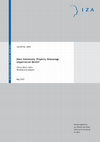Papers by Shoshana Grossbard

Social Science Research Network, 2017
Under the common-law system of coverture in the United States, a married woman relinquished contr... more Under the common-law system of coverture in the United States, a married woman relinquished control of property and wages to her husband. Many U.S. states passed acts between 1850 and 1920 that expanded a married woman's right to keep her market earnings and to own separate property. The former were called married women's earnings acts (MWEAs) and the latter married women's property acts (MWPAs). Scholarly interest in the acts' effects is growing. Researchers have examined how the acts affected outcomes such as women's wealth-holding and educational attainment. The acts' impact on women's non-marital birth decisions remains unexamined, however. We postulate that the acts caused women to anticipate greater benefits from having children within rather than outside of marriage. We thus expect passage of MWPAs and MWEAs to reduce the likelihood that single women become mothers of young children. We use probit regression to analyze individual data from the U.S. Census for the years 1860 to 1920. We find that the property acts in fact reduced the likelihood that single women have young children. We also find that the "de-coverture" acts' effects were stronger for literate women, U.S.-born women, in states with higher female labor-force participation, and in more rural states, consistent with predictions. JEL-Codes: D100.
Economics & Human Biology

Informal eldercare is often supplied by family members, more so in Asia than in the West. Childre... more Informal eldercare is often supplied by family members, more so in Asia than in the West. Children and their parents as well as members of adjacent generations linked by marriage (in-laws) are modeled as self-interested agents offering or responding to material incentives. A first implication from the model is that studies of the impact of eldercare on the health and happiness of in-family caregivers could be enriched by taking account of material in-marriage transfers that the children of the needy elderly can possibly give to their spouses. A second implication discussed here is that the provision of care for older in-laws could be related to the presence of brideprice or dowry transfers (or their in-kind equivalents) and that within a society with a given set of premarital traditions the amount of such transfer will vary with the expected amount of care for elderly in-laws. Suggestive evidence was provided based on simple comparisons between some Asian and Western countries and b...
In the USA, husbands are on average two years older than their wives. When people born during a b... more In the USA, husbands are on average two years older than their wives. When people born during a baby boom are ready to get married, there are (...)

The Society for the Advancement of Behavioral Economics held its biannual meetings in San Diego i... more The Society for the Advancement of Behavioral Economics held its biannual meetings in San Diego in June 1999. The major theme of the conference was the reorientation of economics. Recent decades have witnessed an expansion of economics beyond its core theories based on the assumptions of rational self-interest and exogenous preferences. Economists now study a broader scope of topics, including motivation, organization, cultural assimilation, religion, marriage, and many other topics previously considered outside their discipline. Participants were invited to present papers exploring the relationship between economics and other social science disciplines, including psychology, anthropology, sociology, political science, and statistics. The proliferation of research at the intersection of economics with these other disciplines prompts us to ask, what is economics? What differentiates it from other social sciences? Traditional definitions are no longer satisfactory. One such definition...
This paper points to parallels between the economic approach to marriage and Jewish Law. The econ... more This paper points to parallels between the economic approach to marriage and Jewish Law. The economic approach is applied to the sex ratio question, the price of Torah scholars, the need for marriage brokers, marriage contracts and polygamy, all topics also addressed by Jewish law.

SSRN Electronic Journal, 2017
MAy 2017 IZA DP No. 10775 Body-Weight and Women's Hours of Work: More Evidence That Marriage Mark... more MAy 2017 IZA DP No. 10775 Body-Weight and Women's Hours of Work: More Evidence That Marriage Markets Matter * Higher body-weight (BMI) can affect labor supply via its effects on outcomes in both labor markets and marriage markets. To the extent that it is associated with lower prospects of being in couple and obtaining intra-couple transfers, we expect that higher BMI will increase willingness to supply labor in labor markets, especially for women. We use US panel data from the NLSY79 and NLSY97 to examine whether body weight influences hours of work in the labor market. We use sibling BMI as an instrument for own BMI to address potential endogeneity of BMI in hours worked. We find that White women with higher BMI work more. This is true for both single and married White women. Results for other groups of women and men produce mixed results. The extended analysis suggests that what drives the relationship between BMI and hours worked is not lower market wages earned by high-BMI women, but rather lower spousal transfers to married women or lower expected intra-marriage transfers to single women.

IZA Journal of Development and Migration, 2020
We compare the allocation of time of native men and women married to immigrants against their cou... more We compare the allocation of time of native men and women married to immigrants against their counterparts in all-native couples using the American Time Use Survey for the years 2003–18. We find that when intermarried to a native man, immigrant women pay an assimilation price to the extent that, compared to native women in all-native marriages, they work longer hours at paid work, household chores, or both, while their husbands do no extra work. In some cases, they work for just an extra hour per day. Immigrant men do not pay such a price. Some work 34 min less at household chores than native men in all-native marriages, while the native women who marry immigrant men seem to pay a price related to their situation that would be in an all-native marriage. An explanation based on the operation of competitive marriage markets works for immigrant women, but not for immigrant men. Traditionally, gender-based privileges may allow immigrant men to prevent native women from getting a price f...
The Marriage Motive: A Price Theory of Marriage, 2014
The Oxford Handbook of Women and the Economy, 2017
This chapter reviews models of marriage, with special emphasis on how the sex ratio can help expl... more This chapter reviews models of marriage, with special emphasis on how the sex ratio can help explain outcomes such as marriage formation, the intramarriage distribution of consumption goods, labor supply, savings, type of relationship, divorce, and intermarriage. Economic models of marriage pioneered by Gary Becker are reviewed in the first section and then extended in the next section to incorporate the labor market for the work-in-household approach of Grossbard. The following section discusses challenges in identifying exogenous variation in sex ratios and presents empirical evidence on the impact of sex ratios on labor supply, consumption, savings, and several other outcomes.

Review of Economics of the Household, 2021
The COVID-19 pandemic is an unprecedented event with wide-ranging implications. Given that househ... more The COVID-19 pandemic is an unprecedented event with wide-ranging implications. Given that households are at the center of major changes affecting the entire world, the Review of Economics of the Household is publishing a series of issues on COVID-19 and the economics of the household. Here we review eight articles documenting the enormous costs of the COVID containment policies, in particular the school closures that ensued. Individuals paid a heavy cost in terms of disruption in their attachment to the labor force. Children could not go to school and parents were forced to provide extra childcare and spend significant amounts of time helping children continue to learn, while possibly working from home. Domestic violence became more common. These changes have often been traumatic, to the detriment of the well-being and mental health of large numbers of people. Women have paid a higher price than men, as many of the studies demonstrate. Our conclusion calls for policy-makers to prepare for the post-traumatic period: many households will need help.

Review of Economics of the Household, 2021
The COVID crisis has severely hit both the United States and Europe. We construct comparable meas... more The COVID crisis has severely hit both the United States and Europe. We construct comparable measures of the death toll of the COVID crisis suffered by US states and 35 European countries: cumulative fatalities attributed to COVID at 100 days since the pandemic's onset in a particular nation/state. When taking account of demographic, economic, and political factors (but not health-policy related factors) we find that, controlling for population size, cumulative deaths are between 100 and 130% higher in a US state than in a European country. We no longer find a US/ EUROPE gap in fatalities from COVID after taking account of how each nation/state implemented social distance measures. This suggests that various types of social distance measures such as school closings and lockdowns, and how soon they were implemented, help explain the US/EUROPE gap in cumulative deaths measured 100 days after the pandemic's onset in a state or country.

Journal of Empirical Legal Studies, 2019
Under the common‐law system of coverture in the United States, a married woman relinquished contr... more Under the common‐law system of coverture in the United States, a married woman relinquished control of property and wages to her husband. Many U.S. states passed acts between 1850 and 1920 that expanded a married woman's right to keep her market earnings and to own separate property. The former were called married women's earnings acts (MWEAs) and the latter married women's property acts (MWPAs). Scholarly interest in the acts’ effects is growing, with researchers examining how the acts affected outcomes such as women's wealth holding and educational attainment. The acts’ impact on women's nonmarital birth decisions remains unexamined, however. We postulate that the acts caused women to anticipate greater benefits from having children within rather than outside of marriage. We thus expect the passage of MWPAs and MWEAs to reduce the likelihood that single women become mothers of young children. We use probit regression to analyze individual data from the U.S. Cen...

IZA Journal of Labor Economics, 2017
Is BMI related to hours of work through marriage market mechanisms? We empirically explore this i... more Is BMI related to hours of work through marriage market mechanisms? We empirically explore this issue using data from the NLSY79 and NLSY97 and a number of estimation strategies (including OLS, IV, and sibling FE). Our IV estimates (with same-sex sibling’s BMI as an instrument and a large set of controls including wage) suggest that a one-unit increase in BMI leads to an almost 2% increase in White married women’s hours of work. However, BMI is not associated with hours of work of married men. We also find that a one-unit increase in BMI leads to a 1.4% increase in White single women’s hours of work, suggesting that single women may expect future in-marriage transfers that vary by body weight. We show that the positive association between BMI and hours of work of White single women increases with self-assessed probability of future marriage and varies with expected cumulative spousal income. Comparisons between the association between BMI and hours of work for White and Black marrie...

IZA World of Labor, 2016
The availability of common law marriage in a jurisdiction is associated with lower teenage birth ... more The availability of common law marriage in a jurisdiction is associated with lower teenage birth rates, especially among teenagers younger than 18 and among black teenagers. When common law marriage is available married men participate more in the labor market. The availability of common law marriage seems to be associated with more leisure time for married and cohabiting women, who spend one to two hours less per week in work outside the home. In addition to regular marriage, Australia, Brazil, and 11 US states recognize common law (or de facto) marriage, which allows one or both cohabiting partners to claim, under certain conditions, that an informal union is a marriage. France and some other countries also have several types of marriage and civil union contracts. The policy issue is whether to abolish common law marriage, as it appears to discourage couple formation and female labor supply. A single conceptual framework can explain how outcomes are affected by the choice between regular and common law marriage, and between various marriage and civil union contracts. Laws regulating marriage and divorce have more economic and social implications than most policymakers realize. Common law marriage is no exception. Recognizing common law marriage affects couple formation, labor supply, and the decision to have children. These impacts appear to be related to what men and women can expect when they consider cohabitation. Policymakers may want to add the introduction or removal of marriage-related laws-such as common law marriage or choice between legal regimes for distributing assets in case of divorce-to the tools they use to influence labor supply, fertility, and related outcomes. Couple formation among college-educated men and non-college-educated women is discouraged when common law marriage is available. The availability of common law marriage in the US and marriage under a community property contract in France discourages labor market participation of married and cohabiting women. Where common law marriage is available, married and cohabiting women tend to spend more time in household work. The availability of common law marriage may affect couple formation, labor supply, and the decision to have children

European Journal of Political Economy, 2008
This paper investigates the likelihood of an unpartnered birth as a function of laws regulating t... more This paper investigates the likelihood of an unpartnered birth as a function of laws regulating the division of joint property in case of divorce. Based on a rational choice model of marriage and assuming that on average women earn less than men, we predict that women are less likely to have an unpartnered birth when rules for the division of joint property are more advantageous to spouses with lower earnings. We derive more predictions regarding the effects of age, non-intact home, and religiosity, and the interaction between these variables and legal regime regarding divorce. We test our predictions with retrospective data from the Family Fertility Surveys collected in the 1990s. Most of our predictions are confirmed by a multi-country analysis for 17 legal regimes in 12 Western countries as well as single-country analyses for four countries. The results confirm most of our predictions. Our major findings are that the likelihood of an unpartnered birth is higher in countries that offer most women less access to joint property in case of divorce, and that this effect is weaker for teenagers than for women in their twenties.
Current Anthropology, 1976

The Polygamy Question, 2016
A Demand and Supply analysis of marriage that assumes that marriage markets are free leads to the... more A Demand and Supply analysis of marriage that assumes that marriage markets are free leads to the conclusion that polygyny adds to women's value and enhances their well-being. However, wherever polygyny is found institutions are in place to curtail women's freedom and ability to obtain the very best partners in marriage: marriages are arranged for very young women, brideprice is often paid at marriage, employment for women is limited or prohibited, and women's sexual and emotional fulfillment is discouraged by ideological or physical means. Polygyny, an asymmetrical form of plural marriage, tends to serve the interests of the men likely to be polygynists at the expense of other groups. Having the power to institute and maintain polygyny these men also have the power to institute means of preventing women from capturing the gains that they would obtain had they been free to choose their marriage partners. There is no single example of a society that allows polygyny, an asymmetric form of polygamy, and simultaneously gives women the freedom to choose their marriage partners as commonly practiced in Western democracies. Worldwide, in the cultures and societies that have embraced it, polygyny is associated with undesirable economic, societal, physical, and emotional factors related to women's wellbeing. Many of the societies that have tolerated the practice of polygamy simultaneously recognize its harm in the form of institutions that limit the extent that polygyny can hurt women. Introduction. This article is based on a report prepared for the Supreme Court of British Columbia, Canada, when it was considering whether to eliminate Canada's anti-polygamy law (Grossbard 2010). It analyzes polygyny (many wives), not polyandry (many husbands) and relies on two assumptions often used since Becker's (1973) path-breaking economic analyses of marriage: (1) marriage is an institution that organizes household production, such production including giving birth, raising children, homemaking and many more activities, and (2) marriage markets exist. The economic analysis presented here starts with a Demand and Supply analysis of marriage pioneered by University of Chicago economist Gary Becker. From this analysis Becker (1973, 1981, 2006) concludes that polygyny adds to women's value based on a third assumption: marriage markets are free in the sense that the participants are free to choose and equilibrium prices are allowed to be established where markets clear. The results of a marriage market analysis depend strongly on whether all participants in marriage markets are free to maximize their own wellbeing. However, cultures allowing polygamy invariably also have laws and customs that prevent women from capturing the gains from marriage that could have accrued to them had they been free to choose their husbands. This paper lists and discusses some of these institutions. It then documents some of the harmful effects of polygyny for women and briefly discusses institutions aimed at alleviating this harm. From the perspective of political economy institutions are created and maintained due to the interests and influence of various groups in society. This also holds for marital institutions such as monogamy laws and bride price. The men who have an interest in establishing and











Uploads
Papers by Shoshana Grossbard